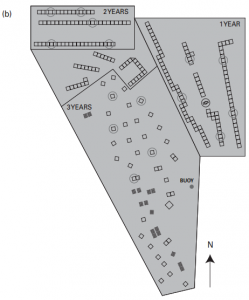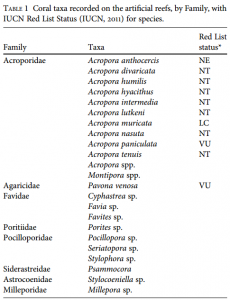
 Reef restoration involves artificially planting coral reefs on the sea bed. The project described here was initiated by Pak Dodent and the staff of Rubiah Tirta Divers, on Pulau Weh, Aceh, Indonesia.
Reef restoration involves artificially planting coral reefs on the sea bed. The project described here was initiated by Pak Dodent and the staff of Rubiah Tirta Divers, on Pulau Weh, Aceh, Indonesia.
The artificial reefs consisted of concrete modules placed on the seabed of sand and rubble (fig b). There were a total of 260 modules.
Concrete modules consisted of cylinder-shaped blocks protruding from the upper surface, contained within four oblong blocks with sloping sides and four sections of pipe for attachment of coral fragments (fig a).
Live coral samples were taken from adjacent healthy reefs and then were attached to the upright plastic pipes with cable ties (Fig 2; Plate 1b). Divers manoeuvred the blocks into position by hand on the seabed, where they were allowed to condition. The total cost of the project was US$8500.
 Results
Results

 The artificial reefs were quickly colonized by numerous coral recruits (Plate 1c). A total of 23 coral taxa from 8 families were recorded on the artificial reefs. These included seven species categorized as Near Threatened and two categorized as Vulnerable on the IUCN Red List (Table 1).
The artificial reefs were quickly colonized by numerous coral recruits (Plate 1c). A total of 23 coral taxa from 8 families were recorded on the artificial reefs. These included seven species categorized as Near Threatened and two categorized as Vulnerable on the IUCN Red List (Table 1).
The artificial reefs were also colonized by numerous reef fish (Plate1d). A total of 29 reef fish species were found in swims across the artificial reefs (Table 2).
An Unfortunate End
Although the project proved to be successful even with low funds and little technology, it is only feasible as a small-scale measure.
Unfortunately, the artificial reef project came to an untimely end when almost 100% of the coral colonies were killed following a rapid rise in sea water temperatures in May 2010 (Plate 1e).
This artificial reef project demonstrates that there are, nonetheless, good reasons for supporting artificial reef projects; benefits include raising awareness both locally and nationally of coral reef conservation issues, the promotion of community-based tourism, and socioeconomic benefits from an increase in employment for the local people.
Coral reef restoration should be seen as a viable small scale measure, but only after larger-scale causes of damage, such as land-based sources of pollution, climate change, and over-fishing practices, have been addressed.
This project and the pictures shown are documented in this academic journal:
Nur Fadli, Stuart J. Campbell, Kathryn Ferguson, Jude Keyse, Edi Rudi, Arthur Riedel and Andrew H. Baird (2012). The role of habitat creation in coral reef conservation: a case study from Aceh, Indonesia. Oryx, 46, pp 501-507. doi:10.1017/S0030605312000142.